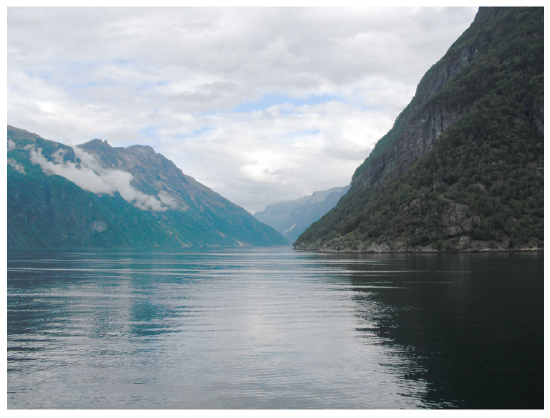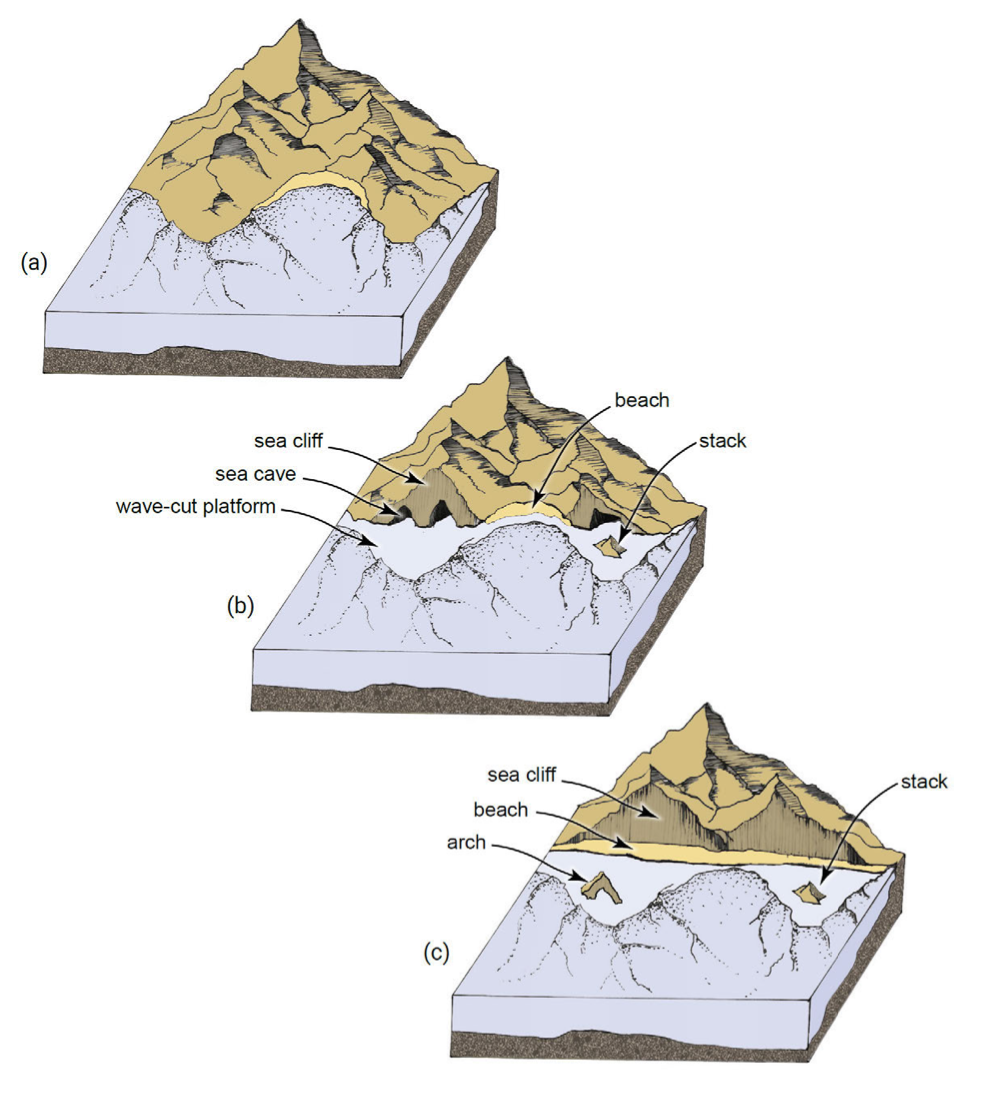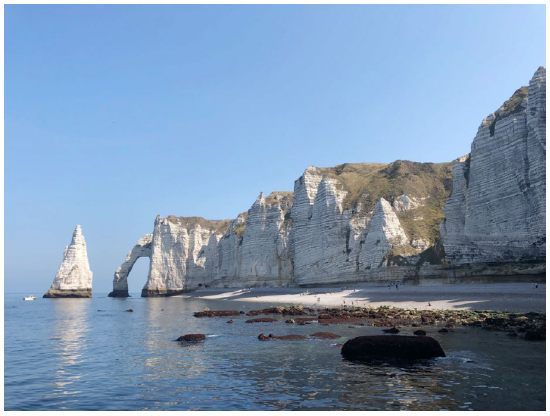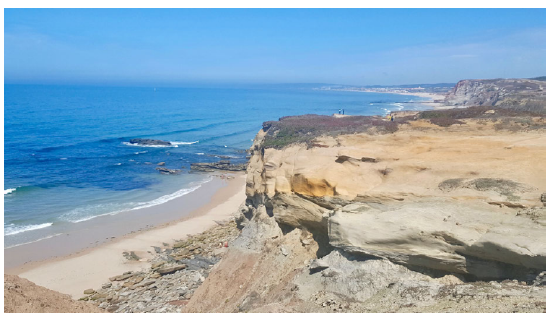2.4: Pleistocene inheritance of cliffed coasts
- Page ID
- 16177
\( \newcommand{\vecs}[1]{\overset { \scriptstyle \rightharpoonup} {\mathbf{#1}} } \)
\( \newcommand{\vecd}[1]{\overset{-\!-\!\rightharpoonup}{\vphantom{a}\smash {#1}}} \)
\( \newcommand{\id}{\mathrm{id}}\) \( \newcommand{\Span}{\mathrm{span}}\)
( \newcommand{\kernel}{\mathrm{null}\,}\) \( \newcommand{\range}{\mathrm{range}\,}\)
\( \newcommand{\RealPart}{\mathrm{Re}}\) \( \newcommand{\ImaginaryPart}{\mathrm{Im}}\)
\( \newcommand{\Argument}{\mathrm{Arg}}\) \( \newcommand{\norm}[1]{\| #1 \|}\)
\( \newcommand{\inner}[2]{\langle #1, #2 \rangle}\)
\( \newcommand{\Span}{\mathrm{span}}\)
\( \newcommand{\id}{\mathrm{id}}\)
\( \newcommand{\Span}{\mathrm{span}}\)
\( \newcommand{\kernel}{\mathrm{null}\,}\)
\( \newcommand{\range}{\mathrm{range}\,}\)
\( \newcommand{\RealPart}{\mathrm{Re}}\)
\( \newcommand{\ImaginaryPart}{\mathrm{Im}}\)
\( \newcommand{\Argument}{\mathrm{Arg}}\)
\( \newcommand{\norm}[1]{\| #1 \|}\)
\( \newcommand{\inner}[2]{\langle #1, #2 \rangle}\)
\( \newcommand{\Span}{\mathrm{span}}\) \( \newcommand{\AA}{\unicode[.8,0]{x212B}}\)
\( \newcommand{\vectorA}[1]{\vec{#1}} % arrow\)
\( \newcommand{\vectorAt}[1]{\vec{\text{#1}}} % arrow\)
\( \newcommand{\vectorB}[1]{\overset { \scriptstyle \rightharpoonup} {\mathbf{#1}} } \)
\( \newcommand{\vectorC}[1]{\textbf{#1}} \)
\( \newcommand{\vectorD}[1]{\overrightarrow{#1}} \)
\( \newcommand{\vectorDt}[1]{\overrightarrow{\text{#1}}} \)
\( \newcommand{\vectE}[1]{\overset{-\!-\!\rightharpoonup}{\vphantom{a}\smash{\mathbf {#1}}}} \)
\( \newcommand{\vecs}[1]{\overset { \scriptstyle \rightharpoonup} {\mathbf{#1}} } \)
\( \newcommand{\vecd}[1]{\overset{-\!-\!\rightharpoonup}{\vphantom{a}\smash {#1}}} \)
\(\newcommand{\avec}{\mathbf a}\) \(\newcommand{\bvec}{\mathbf b}\) \(\newcommand{\cvec}{\mathbf c}\) \(\newcommand{\dvec}{\mathbf d}\) \(\newcommand{\dtil}{\widetilde{\mathbf d}}\) \(\newcommand{\evec}{\mathbf e}\) \(\newcommand{\fvec}{\mathbf f}\) \(\newcommand{\nvec}{\mathbf n}\) \(\newcommand{\pvec}{\mathbf p}\) \(\newcommand{\qvec}{\mathbf q}\) \(\newcommand{\svec}{\mathbf s}\) \(\newcommand{\tvec}{\mathbf t}\) \(\newcommand{\uvec}{\mathbf u}\) \(\newcommand{\vvec}{\mathbf v}\) \(\newcommand{\wvec}{\mathbf w}\) \(\newcommand{\xvec}{\mathbf x}\) \(\newcommand{\yvec}{\mathbf y}\) \(\newcommand{\zvec}{\mathbf z}\) \(\newcommand{\rvec}{\mathbf r}\) \(\newcommand{\mvec}{\mathbf m}\) \(\newcommand{\zerovec}{\mathbf 0}\) \(\newcommand{\onevec}{\mathbf 1}\) \(\newcommand{\real}{\mathbb R}\) \(\newcommand{\twovec}[2]{\left[\begin{array}{r}#1 \\ #2 \end{array}\right]}\) \(\newcommand{\ctwovec}[2]{\left[\begin{array}{c}#1 \\ #2 \end{array}\right]}\) \(\newcommand{\threevec}[3]{\left[\begin{array}{r}#1 \\ #2 \\ #3 \end{array}\right]}\) \(\newcommand{\cthreevec}[3]{\left[\begin{array}{c}#1 \\ #2 \\ #3 \end{array}\right]}\) \(\newcommand{\fourvec}[4]{\left[\begin{array}{r}#1 \\ #2 \\ #3 \\ #4 \end{array}\right]}\) \(\newcommand{\cfourvec}[4]{\left[\begin{array}{c}#1 \\ #2 \\ #3 \\ #4 \end{array}\right]}\) \(\newcommand{\fivevec}[5]{\left[\begin{array}{r}#1 \\ #2 \\ #3 \\ #4 \\ #5 \\ \end{array}\right]}\) \(\newcommand{\cfivevec}[5]{\left[\begin{array}{c}#1 \\ #2 \\ #3 \\ #4 \\ #5 \\ \end{array}\right]}\) \(\newcommand{\mattwo}[4]{\left[\begin{array}{rr}#1 \amp #2 \\ #3 \amp #4 \\ \end{array}\right]}\) \(\newcommand{\laspan}[1]{\text{Span}\{#1\}}\) \(\newcommand{\bcal}{\cal B}\) \(\newcommand{\ccal}{\cal C}\) \(\newcommand{\scal}{\cal S}\) \(\newcommand{\wcal}{\cal W}\) \(\newcommand{\ecal}{\cal E}\) \(\newcommand{\coords}[2]{\left\{#1\right\}_{#2}}\) \(\newcommand{\gray}[1]{\color{gray}{#1}}\) \(\newcommand{\lgray}[1]{\color{lightgray}{#1}}\) \(\newcommand{\rank}{\operatorname{rank}}\) \(\newcommand{\row}{\text{Row}}\) \(\newcommand{\col}{\text{Col}}\) \(\renewcommand{\row}{\text{Row}}\) \(\newcommand{\nul}{\text{Nul}}\) \(\newcommand{\var}{\text{Var}}\) \(\newcommand{\corr}{\text{corr}}\) \(\newcommand{\len}[1]{\left|#1\right|}\) \(\newcommand{\bbar}{\overline{\bvec}}\) \(\newcommand{\bhat}{\widehat{\bvec}}\) \(\newcommand{\bperp}{\bvec^\perp}\) \(\newcommand{\xhat}{\widehat{\xvec}}\) \(\newcommand{\vhat}{\widehat{\vvec}}\) \(\newcommand{\uhat}{\widehat{\uvec}}\) \(\newcommand{\what}{\widehat{\wvec}}\) \(\newcommand{\Sighat}{\widehat{\Sigma}}\) \(\newcommand{\lt}{<}\) \(\newcommand{\gt}{>}\) \(\newcommand{\amp}{&}\) \(\definecolor{fillinmathshade}{gray}{0.9}\)The larger part (about 75%) of the world’s continental and island margins is lined with cliffs, consisting of rocks or cohesive clays. As we have seen in Sect. 2.3.2, cliffed coasts are commonly tectonically active convergent coasts, which produce a rocky, high-relief border. Because they are formed on continental plate margins, under which an oceanic plate is descending, virtually no continental shelf is present. The western edges of North and South America were seen to be good examples of this type of coast.

There are also cliffed coasts of which the origin is unrelated to plate tectonics. In these cases the adjacent continental shelf is wide, with a gentle slope. First we mention Pleis-tocene glaciers having had a hand in producing cliffed coasts. The moving ice masses gouged out steep valleys, which were subsequently drowned as the sea level rose during an interglacial period. Examples of these so-called fjords) are found along the coasts of Alaska, Scandinavia and Scotland. Although their profiles are similar, some fjords are rocky and others are not. In Fig. 2.12, the rocky coast along a Norwegian fjord is shown. It is carved by a glacier.
Still other cliffed coasts are formed of glacial till, sediment deposited by glaciers be- neath and at the margins of the ice. The till is over 100 m thick in some places and includes nearly any type of material from stiff clays to sand, gravel and boulders. Some of it is well layered and some is massive, with essentially no internal coherence. The accumulations known as end moraines tend to be linear and thick. When these end moraines meet the sea, the waves sculpt steep bluffs. Coasts formed by glacial till are also found in Scotland, Denmark and the United Kingdom.
Another variety of rocky and commonly cliffed coast is associated with areas where the continental shelf and adjacent coast are dominated by carbonate sediments as a result of skeletal shell and coral debris. In the Pleistocene, onshore winds blew the carbonate sediment landward, where it accumulated in wide beaches and dunes. In a process called lithification, the calcium carbonate grains are welded together by a cement that is created as ocean spray or percolating ground water reacts with the calcium carbonate. The evaporation of the regularly wetted surfaces in arid climates enhances the lithification of the sediments. The rapid cementation converts the dunes to a rock called eolianite. The coast of North Africa is well known for its cemented sand, which hampers dredging operations because in surveys it appears to be sand, whereas it is quite hard in reality. Similarly, on the beach we find the so-called beach rock, which can be a nuisance for dredging operations.

The Cliffs of Moher (Fig. 2.13) are made up of layer upon layer of sand, silt and mud, compacted into solid rock. These sediments were carried into an ancient sea by large rivers.



Erosion rates of cliffed coasts strongly depend on lithological factors. Typical erosion rates for rock are \(10^{-1}\ m/yr\) to 1 \(m/yr\) for chalk, \(10^{-3}\ m/yr\) to \(10^{-2}\ m/yr\) for limestone and \(10^{-3}\ m/yr\) for granite. Along rocky coasts, nearshore wave energy is often high because the size of the waves is related to the nearshore bathymetry (see Sect. 2.3.3) and to refraction patterns. The wave energy is focused on the headlands (see Fig. 5.6) and dispersed in the bays, so the headlands erode as the intervening bays fill up. Wave erosion of an indented coastline produces a straightened, cliff-bound coast, as shown in Fig. 2.14. Wave-cut platforms and isolated stacks and arches may be left offshore (see Figs. 2.15 and 2.16).
Because of our focus on sandy (and to a lesser extent muddy) coastal systems, the processes of cliff and rock erosion are not considered any further in these lecture notes.


